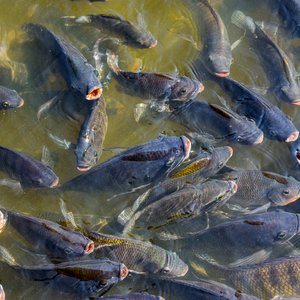This shift has been stimulated by changing consumer preferences for species that require production in feed-based systems, as well as by economics. This has in turn stimulated rapid growth in the feed manufacturing sector, and particularly in the production of extruded aquafeeds.
Feed quality has also improved significantly. High quality, extruded aquafeeds are widely available in all of the eastern and southern coastal provinces, and some of the interior provinces, such as Sichuan. Estimated complete feed production is in excess of 5 million tonnes; total aquafeed production, including on-farm production, is in the range of 15 to 20 million tonnes.
Use of plant proteins as replacement for fishmeal in aquafeeds has also proceeded rapidly in response to the increasing cost for imported fishmeal. In 2002, prices for high quality, imported fishmeal ranged from RMB 6,500 to RMB 8,000 per tonne (U.S.$787 to $969), which was significantly higher than plant protein meals, including soybean meal.
Soybean meal has increasingly become the primary replacement ingredient for fishmeal in freshwater fish feeds, as well as a major component in marine fish feeds. A rapid increase in soybean meal demand by all animal feed industries (swine, fish, poultry) has resulted in a shift in the soybean crushing sector, from a sector driven by oil to one driven by meal. Estimated soybean meal demand by the China aquaculture industry is approximately 4 million tonnes per year.
Overall growth in the China aquaculture industry has slowed dramatically from the 20% to 25% per year exhibited in the mid-1990s. Growth of the freshwater sector has declined to about 5% per annum. Growth of the coastal aquaculture sector, however, has been substantial in the past four years. China currently has an estimated 750,000 to 800,000 near-shore fish production cages, and an estimated 600 large, offshore cages. The Ministry of Agriculture is placing particular emphasis on the development of offshore cages, and has made this a high priority in their 5-year development plan.
In addition, the MOA is promoting the adoption of high quality feeds in coastal aquaculture to replace the use of trash fish. The use of trash fish has contributed to significant coastal pollution and fish disease problems. The American Soybean Association (ASA) has demonstrated in coastal feeding trials that the feed cost per unit of fish growth with high quality manufactured aquafeeds is less than half that with trash fish, with significantly reduced water pollution and the elimination of many disease problems. ASA and the MOA are working cooperatively to demonstrate the use of high quality marine fish feeds in the coastal sector.
GRASS ROOT INITIATIVES TO INCREASE SOY IN AQUAFEED
The American Soybean Association can take credit for its contribution to the improvement in feed technology in China as well as wider use of soybean meal.
The organization has operated an aquaculture program in China for more than a decade with the primary objective to increase soybean meal use in the world’s largest aquaculture industry.
The ASA program has several components aimed at increasing soy product use in aquaculture. This includes developing and field testing soy-based aquafeeds for a wide range of freshwater and marine fish species.
Field testing is done in ponds and cages on commercial fish farms throughout the eastern half of China. ASA has developed and field tested soy-based fry, fingerling and growout feeds for most of the freshwater omnivorous fish species cultured in China, including common, crucian, grass and black carp, wuchang bream, tilapia, and catfish.
ASA has also developed high soy-inclusion feeds for many of the key marine cultured fish species, including Japanese sea bass, red drum, yellow croaker, pompano and snapper species.
The association works with dozens of feed mills in all of the major aquaculture production regions of China, to improve feed quality — both nutritionally and physically — and to assist feed mills in upgrading their capabilities for and knowledge of fish nutrition, feed formulation and quality control.
An important component of ASA’s program is the training of national and provincial fisheries’ extension agents in the principles of aquaculture and feed-based production technologies.
The Association has trained several thousand extension agents in long- and short-term general and specialized training programs.
It also trains fish farmers in aquaculture principles and feed-based production technologies and operates a farmer assistance program that includes on-site farm visits and feeding trials to help farmers test and adopt modern feed-based production technologies.








